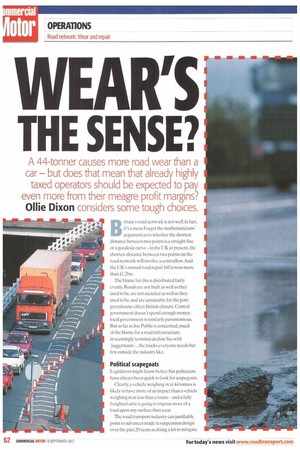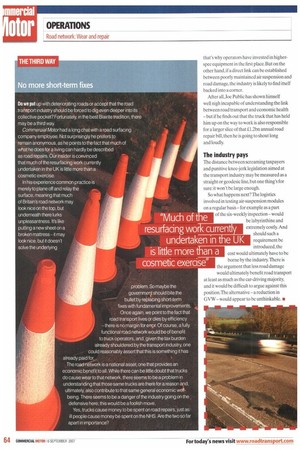WEAR'S THE SENSE?
Page 62

Page 63

Page 64

If you've noticed an error in this article please click here to report it so we can fix it.
A 44-tonner causes more road wear than a car — but does that mean that already highly taxed operators should be expected to pay even more from their meagre profit margins? 011ie Dixon considers some tough choices.
Britain's road network is not well;in fact, it's a mess. Forget the mathematicians' argument as to whether the shortest distance between two points is a straight line or a geodesic curve — in the UK at present, the shortest distance between two points on the road network will involve a contrallow.And the UK's annual road repair bill is now more than £1.2bn.
The blame for this is distributed fairly evenly. Roads are not built as well as they used to be, are not mended as well as they used to be, and are unsuitable for the postgreenhouse-effect British climate. Central government doesn't spend enough money; local government is similarly parsimonious. But as far as Joe Public is concerned, much of the blame for a road infrastructure in seemingly terminal decline lies with ' juggernauts'... the trucks everyone needs but few outside the industry like.
Political scapegoats
Legislators might know better, but politicians have always been quick to look for scapegoats.
Clearly, a vehicle weighing in at 44 tonnes is likely to have more of an impact than a vehicle weighing in at less than a tonne — and a fully freighted artic is going to impose more of a load upon any surface than a car.
The road transport industry can justifiably point to advances made in suspension design over the past 20 years as doing a lot to mitigate the impact of LGVs on the road network.
Again, this seems self-evident: a steel-sprung I38-tonner on five axles makes more of an impact than a six-axle 44-ton.ner running on road-friendly air suspension.
But there's more to this than meets the eye.Yes, EU legislation encourages the use of air suspension because of its road-friendly nature. However, there is no EU requirement for in-service maintenance or performance I monitoring of this 'friendly' suspension, even though poorly maintained air suspension can cause significantly more damage to the road surface than a conventional leaf-spring design.
Examining the evidence
Don't take our word for it — the Cambridge Vehicle Dynamics Consortium (www.cvdc. org) is a leading authority on heavy vehicles and road damage, and leader Professor David Cebon cites a paper published recently in the Journal of Mechanical Engineering Science on just this subject.
The conclusion reached by this study — conducted in Australia — is that a properly maintained airsuspension design will cut road maintenance costs by 14% compared with steel suspension... assuming the air-sprung truck is the same weight as its steel-sprung counterpart.
But if you acknowledge the benefits of air by raising the weight limit cm road-friendly suspension, as the EU has done, then the saving in road maintenance costs falls to 1%. When the bill runs to billions, a I % saving is still significant — but now let's assume the heavier trucks in the air-suspended fleet are running with 50% of their suspension modules working at less than optimum efficiency... suddenly this 'road-friendly' fleet is incurring road maintenance costs that are 21% more than the conventionally sprung fleet.
The reason for this is simple enough: if the hydraulic dampers on air suspensions do not function correctly, the vehicle will bounce up and down, generating forces that damage the road surface.
This leaves the industry with a dilemma. On the one hand, road transport is a low-margin business that demands maximum efficiency; 111. that's why operators have invested in higherspec equipment in the first place. But on the other hand, if a direct link can be established between poorly maintained air suspension and road damage, the industry is likely to find itself backed into a corner.
After all, Joe Public has shown himself well nigh incapable of understanding the link between road transport and economic health — but if he finds out that the truck that has held him up on the way to work is also responsible for a larger slice of that £.1.2bn annual road repair bill, then he is going to shout long and loudly.
The industry pays
The distance between screaming taxpayers and punitive knee-jerk legislation aimed at the transport industry may be measured as a straight or geodesic line, but one thing's for sure: it won't be large enough.
So what happens next? The logistics involved in testing air-suspension modules on a regular basis — for example as a part of the six-weekly inspection — would be labyrinthine and extremely costly. And should such a requirement be introduced, the cost would ultimately have to be borne by the industry. There is the argument that less road damage would ultimately benefit road transport at least as much as the car-driving majority, and it would be difficult to argue against this position.The alternative — a reduction in GVW— would appear to be unthinkable. •
































































































































































































